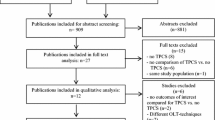Summary.
The experience with laterolateral cavocavostomy for hepatovenous reconstruction in liver transplantation is reviewed with and without the use of a temporary portocaval shunt. A total of 65 liver transplantations were analyzed. In 49 transplantations a laterolateral cavocaval anastomosis was performed (group I). In group II (n = 16) the same technique was used after a temporary portal caval shunt was constructed. Mean arterial pressure (mmHg): group I 128 ± 34; group II 109 ± 32. Cardiac output (l/min) decrease during the anhepatic phase was 2.3 ± 1.9 and 1.2 ± 1.5, respectively (P < 0.05). The peroperative blood loss measured as the number of packed cells transfused was 16.4 ± 15.8 versus 1.2 ± 2.3 (P < 0.04) and fresh frozen plasma 19.0 ± 14.7 versus 3.7 ± 4.0 (P < 0.02). Course on ICU (days), liver function tests, renal function and the need for reoperation because of bleeding were not statistically significantly different between the groups. One-year patient survival was 82.7 and 85.7 %, respectively. In conclusion, we found that despite preservation of the caval flow during hepatectomy, the additional use of a temporary portocaval shunt was advantageous with regard to peroperative hemorrhage and hemodynamic stability and can potentially facilitate implantation of the liver graft.
Zusammenfassung.
Die laterolaterale Cavocavostomie zur hepatovenösen Rekonstruktion bei der Lebertransplantation wird vorgestellt, mit und ohne Anlage eines temporären portocavalen Shunts. Insgesamt 65 Lebertransplantationen wurden analysiert. Bei 49 Transplantationen wurde eine laterolaterale cavocavale Anastomose angelegt (Gruppe I). Bei 16 weiteren Patienten (Gruppe II) wurde ein temporärer portocavaler Shunt während der Hepatektomie durchgeführt. Der gemittelte arterielle Blutdruck betrug in mmHg für Gruppe I 128 ± 34, in Gruppe II 109 ± 32. Das Herzzeitvolumen (l/min) reduzierte sich während der anhepatischen Phase bei Gruppe I um 2,3 ± 1,9 bei Gruppe II um 1,2 ± 1,5 (p < 0,05). Der perioperative Blutverlust gemessen an der Anzahl Erythrocytenkonzentrate betrug 16,4 ± 15,8 in Gruppe I versus 1,2 ± 2,3 in Gruppe II (p < 0,04) an der Anzahl Einheiten Frischplasma 19,0 ± 14,7 vs. 3,7 ± 4,0 (p < 0,02). Der Verbleib auf der Intensivstation in Tagen, die Leberfunktionsteste sowie die renale Funktion und die Häufigkeit erforderlicher Reoperationen wegen Blutung waren nicht statistisch signifikant unterschiedlich zwischen den beiden Gruppen. Die 1-Jahres-Überlebensrate betrug 82,7 % bzw. 85,7 %. Schlußfolgerung: Die Anlage eines temporären portocavalen Shunts kann bei der Cava-erhaltenden Hepatektomie und Spender-zu-Empfänger-Cavocavostomie zu besserer hämodynamischer Stabilität, weniger Blutverlust und vereinfachter Transplantatimplantation beitragen.
Similar content being viewed by others
Author information
Authors and Affiliations
Rights and permissions
About this article
Cite this article
Hesse, U., Berrevoet, F., Troisi, R. et al. Die Lebertransplantation mit Erhalt der Vena cava und einem temporären portocavalen Shunt. Chirurg 70, 174–177 (1999). https://doi.org/10.1007/s001040050065
Published:
Issue Date:
DOI: https://doi.org/10.1007/s001040050065




